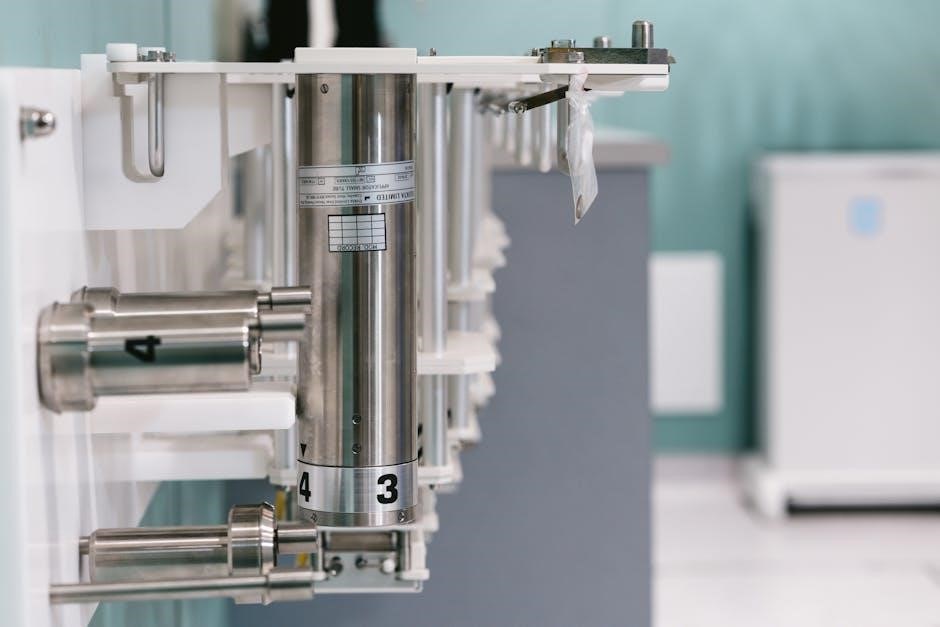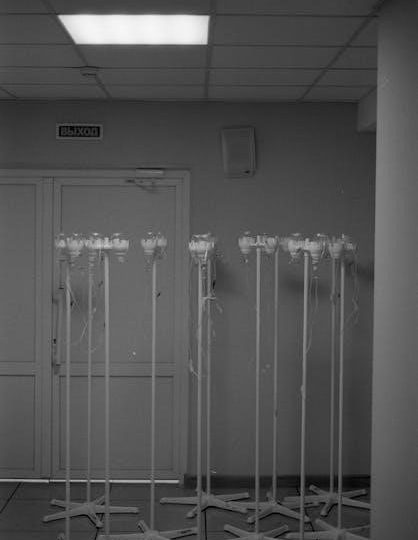The Structured Clinical Interview for DSM-5 (SCID-5) is a semi-structured interview guide for making major DSM-5 diagnoses, administered by clinicians or trained professionals. It ensures accurate and reliable diagnostic assessments across various clinical and research settings.
1.1 Overview of the SCID-5
The SCID-5 is a semi-structured interview guide designed to assist clinicians in diagnosing mental disorders according to the DSM-5 criteria. It provides a standardized approach to ensure accurate and reliable diagnostic assessments. Widely used in both clinical and research settings, the SCID-5 helps mental health professionals make consistent diagnoses, facilitating effective treatment plans. It covers a broad range of mental health conditions, ensuring comprehensive evaluation and accurate DSM-5 classification.
1.2 Importance of Structured Clinical Interviews in Psychiatry
Structured clinical interviews, such as the SCID-5, play a vital role in psychiatry by ensuring reliable and consistent diagnostic assessments. They minimize variability in clinicians’ interpretations, enhancing the accuracy of DSM-5 diagnoses. These interviews provide a standardized framework for evaluating mental health conditions, which is essential for effective treatment planning. Additionally, they facilitate communication among healthcare professionals and are invaluable in research settings for ensuring consistent data collection. The SCID-5, in particular, supports both clinical practice and research by offering a comprehensive yet practical approach to diagnosing mental disorders, thereby improving patient outcomes and advancing psychiatric care.
1.3 Brief History of the SCID
The Structured Clinical Interview for DSM-5 (SCID-5) has its roots in earlier versions developed for previous DSM editions. The original SCID was created for DSM-III and later adapted for DSM-IV, becoming a gold standard in psychiatric diagnosis. Over time, it evolved to incorporate changes in diagnostic criteria and improvements in clinical practice. The transition to DSM-5 brought significant updates, leading to the development of the SCID-5, which reflects contemporary understandings of mental disorders. This evolution ensures the SCID remains a reliable and essential tool for clinicians and researchers, maintaining its relevance in modern psychiatry and mental health care.

Versions of the SCID-5
The SCID-5 is available in multiple versions, including the Clinician Version (SCID-5-CV), Research Version (SCID-5-RV), and Personality Disorders Version (SCID-5-PD), each tailored for specific clinical and research needs.
2.1 SCID-5-CV (Clinician Version)
The SCID-5-CV (Clinician Version) is a streamlined diagnostic tool designed for use in clinical settings. It provides a comprehensive yet concise assessment of the most common DSM-5 diagnoses, making it practical for routine patient evaluations. The SCID-5-CV is structured to guide clinicians through a systematic interview process, ensuring accurate and reliable diagnoses. It includes a detailed user guide that offers instructions for administering the interview effectively. This version is ideal for mental health professionals who need a time-efficient tool for assessing psychiatric conditions in everyday practice. The SCID-5-CV is also adaptable for use in research settings when the focus aligns with the disorders included in the clinician version.
2.2 SCID-5-RV (Research Version)
The SCID-5-RV (Research Version) is the most comprehensive version of the SCID-5, designed for in-depth diagnostic assessments in research settings. It includes a wide range of DSM-5 disorders, subtypes, and severity specifiers, making it highly customizable for specific studies. Researchers can tailor the interview to focus on disorders relevant to their work, ensuring flexibility and precision. The SCID-5-RV also includes a detailed User’s Guide and score sheets to facilitate accurate data collection and analysis. This version is particularly suited for large-scale studies and clinical trials, where thorough diagnostic evaluation is essential. Its structured format ensures consistency across assessments, enhancing the reliability of research findings.
2.3 SCID-5-PD (Personality Disorders Version)
The SCID-5-PD is specifically designed to assess the 10 DSM-5 Personality Disorders, reflecting the elimination of the multiaxial system in DSM-5. While the diagnostic criteria for Personality Disorders remain unchanged from DSM-IV, the interview questions have been refined to better capture the constructs outlined in DSM-5. This version includes a self-report patient questionnaire, the SCID-5-SPQ, to streamline the assessment process by allowing clinicians to bypass irrelevant questions based on patient responses. The SCID-5-PD is an essential tool for diagnosing Personality Disorders in clinical and research settings, ensuring accurate and reliable evaluations of personality psychopathology.
2.4 SCID-5-CT (Clinical Trials Version)
The SCID-5-CT is an adaptation of the SCID-5-RV, optimized for use in clinical trials. It is reformatted and streamlined to align with typical inclusion and exclusion criteria, making it efficient for trial settings. This version maintains the reliability and validity of the SCID-5 while tailoring it to the specific needs of clinical trials. Two options are available for those interested in using the SCID-5-CT, offering flexibility based on the requirements of the trial. It is a valuable tool for ensuring accurate diagnoses in research and pharmaceutical studies, contributing to the advancement of mental health treatments.
2.5 QuickSCID-5 (Abbreviated Version)
The QuickSCID-5 is a streamlined diagnostic tool derived from the SCID-5, designed for time-efficient assessments. It typically takes 30 minutes or less to administer, focusing on essential questions to identify common psychiatric conditions. This abbreviated version is ideal for busy clinical settings, offering a practical approach while maintaining the reliability of the SCID-5 framework. The QuickSCID-5 is particularly useful for screening purposes, providing a concise yet effective method for diagnosing major DSM-5 disorders. Its brevity makes it accessible for clinicians needing rapid diagnostic insights without compromising accuracy.

Development and Evolution of the SCID-5
The SCID-5 evolved from earlier versions, transitioning to DSM-5 criteria. The American Psychiatric Association led its development, ensuring alignment with updated diagnostic standards and incorporating new assessment approaches.
3.1 Transition from DSM-IV to DSM-5
The transition from DSM-IV to DSM-5 introduced significant changes, including the elimination of the multiaxial system and the integration of dimensional assessments for mental disorders. The SCID-5 was updated to reflect these changes, ensuring alignment with the new diagnostic criteria. Personality disorders, for instance, now incorporate a hybrid model combining categorical and dimensional approaches. The SCID-5-PD was revised to capture these updates accurately. This evolution required careful adaptation of interview questions and diagnostic algorithms to maintain reliability and validity. The transition aimed to enhance clinical utility and research applicability, ensuring the SCID-5 remains a robust tool for accurate DSM-5 diagnoses.
3.2 Key Changes in the SCID-5 Compared to Previous Versions
The SCID-5 features several key changes, including a modular format and updated diagnostic criteria to align with DSM-5. It incorporates dimensional assessments for personality disorders, providing a more nuanced evaluation. The elimination of the multiaxial system in DSM-5 is reflected in the SCID-5 structure. New modules and revised interview questions ensure better clarity and accuracy. The SCID-5 also introduces specialized versions, such as the SCID-5-CV for clinicians and SCID-5-RV for researchers, enhancing its adaptability. These changes improve diagnostic precision and usability across clinical and research settings, making the SCID-5 a more comprehensive and flexible tool for mental health professionals.
3.3 Role of the American Psychiatric Association in SCID Development
The American Psychiatric Association (APA) played a pivotal role in the development of the SCID-5 by overseeing its creation and ensuring alignment with DSM-5 criteria. The APA published the SCID-5, including the Research Version (SCID-5-RV) and Clinician Version (SCID-5-CV), and manages licensing for its use. The APA also provided updates and adaptations, such as the SCID-5-CT for clinical trials, ensuring the tool meets diverse clinical and research needs. By maintaining oversight, the APA ensures the SCID-5 remains a reliable and standardized diagnostic instrument, reflecting the latest advancements in psychiatric assessment and practice.

Structure and Content of the SCID-5
The SCID-5 features a modular format, covering diagnostic criteria for DSM-5 disorders, severity assessments, and course specifiers. It includes dimensional evaluations for personality disorders, enhancing diagnostic precision.
4.1 Modular Format of the SCID-5
The SCID-5 is organized into a modular format, allowing clinicians to focus on specific diagnostic categories. Each module corresponds to a group of related disorders, enabling customization based on clinical or research needs. This structure ensures efficiency while maintaining comprehensive coverage. The semi-structured design provides flexibility, enabling clinicians to probe deeply into symptoms while adhering to standardized criteria. The modular approach facilitates systematic assessment, reducing diagnostic variability. It also allows for easier updates as diagnostic criteria evolve. This format is particularly useful in both clinical and research settings, making the SCID-5 a versatile tool for accurate and reliable diagnostic evaluations.
4.2 Diagnostic Criteria Covered in the SCID-5
The SCID-5 is designed to assess a wide range of psychiatric disorders based on DSM-5 criteria. It covers Axis I disorders, including mood, anxiety, psychotic, and substance use disorders, as well as Axis II personality disorders. The interview includes detailed questions to evaluate diagnostic criteria, ensuring comprehensive coverage of symptoms and severity. It also incorporates dimensional assessments for personality disorders, allowing for a deeper understanding of symptom severity. The SCID-5 aligns with DSM-5 updates, such as revised criteria for PTSD and the inclusion of new disorders like binge-eating disorder. This ensures that clinicians can conduct accurate and reliable diagnostic evaluations across diverse clinical populations.
4.3 Assessment of Severity and Course Specifiers
The SCID-5 includes assessments for severity and course specifiers to provide a comprehensive understanding of disorder progression. Severity is evaluated using standardized scales, such as 0-4 for symptom severity and 1-5 for functioning. Course specifiers, like “in partial remission” or “in full remission,” help track illness progression over time. These assessments ensure clinicians can document the clinical picture accurately, aiding in treatment planning and prognosis. The SCID-5 also captures episode duration and recurrence, enhancing the evaluation of long-term outcomes. This detailed approach allows for a nuanced understanding of disorder severity and trajectory, improving diagnostic precision and clinical decision-making.
4.4 Incorporation of Dimensional Assessment in Personality Disorders
The SCID-5 integrates a dimensional assessment approach for personality disorders, allowing clinicians to evaluate the severity of traits rather than relying solely on categorical diagnoses. This method enhances diagnostic precision by capturing the spectrum of personality pathology. The interview includes rating scales for specific traits, such as negative affectivity or disinhibition, enabling a more nuanced understanding of personality disorders. This dimensional approach complements the traditional categorical system, providing a more comprehensive evaluation. It also aligns with the DSM-5’s alternative model for personality disorders, offering flexibility and depth in assessment. This feature is particularly useful for research and clinical settings, aiding in tailored treatment planning and prognosis.

Administration and Scoring of the SCID-5
The SCID-5 is administered by trained professionals, requiring proper preparation and clinical expertise. Scoring involves systematic evaluation of responses, ensuring accurate DSM-5 diagnoses.
5.1 Training Requirements for Administrators
Administering the SCID-5 requires specialized training to ensure accurate and reliable use. Clinicians or mental health professionals must be familiar with DSM-5 diagnostic criteria and structured interview techniques. Proper training involves understanding the SCID-5’s modular format, diagnostic criteria, and scoring procedures. Workshops and user guides are available to enhance competency. Administrators should also practice conducting interviews to improve proficiency. Ongoing education is recommended to stay updated on DSM-5 revisions and SCID-5 enhancements. The American Psychiatric Association offers resources to support training and certification, ensuring administrators are well-prepared to use the SCID-5 effectively in both clinical and research settings.
5.2 Preparation for the SCID-5 Interview
Preparation for the SCID-5 interview is essential to ensure a thorough and accurate assessment. Administrators should review the SCID-5 user guide and familiarize themselves with the diagnostic criteria and structured format. Organizing the interview materials, such as the SCID-5 manual and score sheets, is crucial. A quiet, private setting should be arranged to facilitate open communication. Reviewing the patient’s history and any prior documentation beforehand helps guide the interview. Clinicians should also explain the interview’s purpose and process to the patient to establish trust and cooperation. Proper preparation ensures the interview is conducted efficiently and effectively, adhering to the SCID-5’s standardized approach.
5.3 Conducting the SCID-5 Interview
Conducting the SCID-5 interview requires a structured yet flexible approach. The clinician begins with an open-ended narrative to gather general information, followed by targeted questions to assess specific diagnostic criteria. The interview is semi-structured, allowing clinicians to probe for additional details while adhering to the SCID-5 framework. It is essential to maintain a neutral and empathetic tone to ensure patient comfort and honesty; Clinicians must carefully assess the severity and course of symptoms, using follow-up questions to clarify ambiguous responses. The interview concludes with a summary of findings and, if necessary, feedback to the patient. Proper documentation of responses ensures accurate scoring and interpretation.
5.4 Scoring and Interpretation of SCID-5 Results
Scoring and interpretation of SCID-5 results involve evaluating responses against DSM-5 diagnostic criteria. Clinicians rate symptoms as present, absent, or subthreshold, using a structured format. The User’s Guide provides detailed instructions for scoring and interpreting results. Each module assesses specific disorders, with criteria met coded as “1” and unmet as “0.” Severity and course specifiers are documented to inform treatment planning. Interpretation considers the categorical presence of a disorder and, for personality disorders, dimensional assessments. Clinical judgment is essential to integrate findings and rule out differential diagnoses. Accurate scoring ensures reliable and consistent diagnoses, aiding in both clinical decision-making and research applications.

Clinical Applications of the SCID-5
The SCID-5 is widely used for diagnostic assessments, treatment planning, and research. It aids in accurate DSM-5 diagnoses, guiding clinical decisions and therapeutic interventions effectively.

6.1 Use in Diagnostic Assessments
The SCID-5 is a valuable tool for conducting accurate and reliable diagnostic assessments in clinical settings. It guides clinicians in identifying DSM-5 mental disorders through structured questions, ensuring comprehensive evaluation of symptoms and criteria. This tool is particularly effective in treatment planning, as it provides clear diagnostic outcomes that inform therapeutic interventions. The SCID-5 is widely used in psychiatric and general medical settings, as well as in community surveys, making it a versatile instrument for diverse diagnostic needs. Its standardized approach ensures consistency and accuracy, aiding professionals in making informed clinical decisions.
6.2 Application in Research Settings
The SCID-5 is widely utilized in research settings to ensure reliable and valid diagnostic assessments. The Research Version (SCID-5-RV) is particularly comprehensive, covering a broad range of DSM-5 disorders and their subtypes. Its structured format allows for consistent data collection, making it ideal for large-scale studies and clinical trials. Researchers appreciate its ability to be customized to meet specific study requirements, enhancing its utility in diverse research contexts. The SCID-5-RV is often employed in psychiatric studies, pharmaceutical trials, and epidemiological research, ensuring accurate and standardized diagnostic outcomes. This tool plays a crucial role in advancing mental health research by providing a robust framework for diagnostic evaluation.
6.3 Role in Clinical Trials and Pharmaceutical Studies
The SCID-5 plays a pivotal role in clinical trials and pharmaceutical studies by providing a standardized method for diagnosing mental disorders. The Clinical Trials Version (SCID-5-CT) is specifically optimized for such settings, ensuring that participant eligibility criteria are met accurately. Its structured format allows for reliable assessment of inclusion and exclusion criteria, which is critical for maintaining study integrity. The SCID-5 is also used to monitor treatment effects and ensure participant safety in clinical trials. Its ability to provide consistent and accurate diagnoses makes it an essential tool in pharmaceutical research, aiding in the development of new treatments and therapies.
6.4 Use in Educational and Training Programs
The SCID-5 serves as an essential educational tool for training mental health professionals. It is widely used in academic settings to teach diagnostic interviewing skills, ensuring students understand DSM-5 criteria. The structured format helps novices learn systematic assessment techniques, while its modular design allows focused instruction on specific disorders. Training programs often incorporate the SCID-5 to enhance clinical skills, with educators using it to simulate real-world diagnostic scenarios. Additionally, the availability of various SCID-5 versions caters to different educational needs, from clinical training to research-oriented programs, preparing professionals to apply this tool effectively in practice.

Advantages and Limitations of the SCID-5
The SCID-5 offers reliability and validity, providing a structured approach for consistent diagnostic assessments, but requires substantial time and training, and may not be suitable for all clinical populations.
7;1 Reliability and Validity of the SCID-5
The SCID-5 demonstrates strong reliability and validity as a diagnostic tool, ensuring consistent and accurate mental disorder assessments. Its structured format minimizes variability across administrators, enhancing inter-rater reliability. The tool adheres strictly to DSM-5 criteria, improving diagnostic accuracy. Studies have consistently supported its validity in identifying mental health conditions, making it a trusted resource in both clinical and research settings. The SCID-5’s ability to comprehensively cover diagnostic criteria ensures reliable results, while its semi-structured design allows for detailed exploration of symptoms, further enhancing its validity. These features make the SCID-5 a cornerstone in psychiatric diagnosis and research, providing a robust framework for mental health evaluations.
7.2 Time Efficiency and Practicality
The SCID-5 is designed to balance thoroughness with efficiency, making it practical for both clinical and research settings. The QuickSCID-5, an abbreviated version, can be administered in 30 minutes or less, ideal for time-sensitive environments. Its modular format allows clinicians to focus on relevant sections, streamlining the assessment process. While the Research Version (SCID-5-RV) is more comprehensive, the Clinician Version (SCID-5-CV) is tailored for everyday clinical use, covering common diagnoses. This structure ensures that the SCID-5 remains user-friendly while maintaining its diagnostic rigor, making it a practical tool for mental health professionals.
7.3 Limitations in Certain Clinical Populations
While the SCID-5 is a robust diagnostic tool, it has limitations in certain clinical populations. For example, it may be less effective in assessing children and adolescents due to the lack of specialized modules for pediatric diagnoses. Additionally, its reliance on clinician expertise can lead to variability in administration and interpretation. The SCID-5 may also be challenging to use with non-English speaking populations, as translations and cultural adaptations may not fully capture diagnostic nuances. Furthermore, its structured format can make it less flexible for assessing complex or rare conditions, potentially limiting its utility in specialized clinical settings. These limitations highlight the need for careful clinician training and ongoing updates to enhance its applicability across diverse populations.

Training and Certification for SCID-5 Administrators
Training and certification for SCID-5 administrators are essential for reliable diagnostic assessments, provided through workshops and resources by the American Psychiatric Association to ensure accuracy and consistency in evaluations.
8.1 Importance of Proper Training
Proper training in administering the SCID-5 is crucial for ensuring accurate and reliable diagnostic assessments; Clinicians must be well-versed in DSM-5 criteria and the structured interview format to maintain consistency and validity. Training enables professionals to navigate the semi-structured design effectively, apply diagnostic criteria accurately, and interpret results reliably. Without adequate training, the risk of misdiagnosis or inconsistent assessments increases, potentially impacting clinical decision-making and research integrity. The American Psychiatric Association emphasizes the need for trained professionals to administer the SCID-5, ensuring its effectiveness as a diagnostic tool in both clinical and research settings.
8.2 Available Training Resources and Workshops
The American Psychiatric Association offers comprehensive training resources and workshops to master the SCID-5. These include user guides, online modules, and in-person training sessions designed for clinicians and researchers. Workshops cover the semi-structured interview format, diagnostic criteria, and effective administration techniques. Additionally, the SCID-5 is supported by detailed manuals and score sheets, ensuring proper use. Training programs are tailored for both novice and experienced professionals, emphasizing accurate and reliable diagnostic assessments. These resources ensure that administrators are proficient in using the SCID-5 effectively, whether in clinical practice or research settings.

Future Directions and Updates to the SCID-5
The SCID-5 is expected to evolve with ongoing research and updates from the American Psychiatric Association, ensuring alignment with emerging diagnostic criteria and clinical advancements.
9.1 Ongoing Research and Revisions
Research on the SCID-5 focuses on improving its diagnostic accuracy and adaptability to emerging mental health trends; Revisions aim to refine interview questions, ensuring alignment with DSM-5 updates and clinical practices. Studies explore the integration of dimensional assessments, particularly for personality disorders, to enhance diagnostic precision. The American Psychiatric Association collaborates with experts to incorporate feedback from clinicians and researchers, addressing limitations and expanding the tool’s applicability. These efforts ensure the SCID-5 remains a reliable and versatile instrument for both clinical and research settings, reflecting the latest advancements in psychiatric diagnosis and assessment.
9.2 Integration with Emerging Diagnostic Criteria
The SCID-5 is being adapted to integrate emerging diagnostic criteria, ensuring alignment with advancements in psychiatric diagnosis. Collaborations between researchers and clinicians aim to incorporate new dimensional assessments, particularly for personality disorders, reflecting DSM-5 updates. The SCID-5’s modular design allows for seamless integration of revised criteria, maintaining its relevance in evolving mental health landscapes. Ongoing efforts focus on enhancing cultural sensitivity and addressing diverse clinical populations. By staying attuned to diagnostic advancements, the SCID-5 remains a cornerstone for accurate and contemporary psychiatric evaluations, supporting both research and clinical practice with its adaptable framework.



